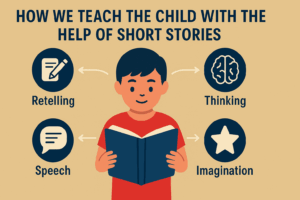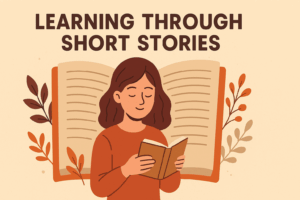Introduction
Short stories hold a special place in early education, especially during the tender years of language development. From the beginning, and throughout early childhood, parents often read stories and poems to their children. However, and despite the benefits of exposure, simply reading isn’t enough. To make children’s speech expressive and clear, and to foster deeper engagement, it is essential to teach them how to retell what they hear. As a result, and with thoughtful guidance, short stories become more than entertainment—they become tools for communication.
Children in primary school usually struggle with retelling. Because of this, and as a natural part of early development, they need support to process and express what they’ve heard. Therefore, and in order to build comprehension, if the child doesn’t understand the story, a brief conversation can lead them toward the meaning. Next, and just as importantly, asking questions after reading helps uncover whether they actually grasped the concept. After that, and only then, should we guide them to retell. As a result, and over time, the child begins learning how to organize thoughts.
Each stage of retelling introduces a different method. At first, you read aloud and let the child add one word or a phrase. Over time, the process evolves. If the child hesitates too much, leading questions can help them move forward. Gradually, you draw up a plan of the story. Then, you take turns, and the child finishes where you leave off. This builds momentum and strengthens confidence in speaking.

Small Steps in Narrative Learning
Notably, these small steps have long-lasting effects. For example, this form of practice trains children to listen deeply and follow speech. Moreover, it develops attention span and helps with memory retention. Over time, this kind of storytelling becomes a natural part of their learning.
Consider a child like Sasha. On a spring day, the snow melted, and streams began to flow. Sasha released paper boats into the water. Suddenly, something buzzed overhead. Sasha looked up and thought it was a bird. But it wasn’t—it was an airplane. While Sasha focused on the sky, the boats drifted away. This simple scene shows how storytelling brings visuals, emotions, and thought together. Therefore, stories aren’t just words—they are moments that stick.
The Role of Short Stories in Early Childhood
Parents often start reading stories to their children very early. From fairy tales to poems, these stories become part of a child’s daily routine. However, reading alone isn’t enough. If children are to develop clear and expressive speech, they need more than passive listening. Instead, they must learn how to retell. That process builds language skills. As a result, short stories grow into stepping stones for communication.
Retelling doesn’t come easy. Especially in primary school, children face difficulties. When they hear a story they don’t understand, they struggle to explain it. So, you start with a simple conversation. This helps introduce the idea of the story. After reading, you ask the child some questions. This checks if the child grasped the meaning. Only then can you expect retelling to happen. Thus, understanding comes before expression.
How Retelling Strengthens Thinking
Retelling is more than repeating. It requires memory, structure, and imagination. At each learning stage, different methods are used. At first, you read a line and let the child insert a word or phrase. That feels like a game. As the child grows, you shift the technique. When pauses grow long, you help by asking leading questions. These prompts unlock ideas. Gradually, you introduce a story plan. The plan helps organize thoughts before speaking. As you tell the first part, the child learns to finish the rest. That builds rhythm and flow. Therefore, storytelling becomes collaborative.
This effort trains more than memory. It teaches focus. It also improves listening. Children begin to notice how other people speak. In turn, they adapt and respond better. As they practice retelling, their confidence rises. Even shy children find it easier to share their thoughts. Hence, short stories work like bridges—they connect thinking to speaking.
Developing Speech and Expression
Clear speech isn’t automatic. Children often understand what they hear but don’t know how to express it. Short stories give them the structure they need. Through retelling, children choose words, form sentences, and shape meaning. Each story offers a pattern. That pattern becomes a template for their own language use. Soon, storytelling shapes how they talk and write.
Because stories contain emotion, they teach tone and feeling. Consequently, children learn that words can sound excited, surprised, or thoughtful. As a result, these cues improve social communication. Furthermore, when retelling includes dialogue or description, children experiment with expressive speech. In turn, this opens up their personality. Moreover, it also supports reading comprehension. So, retelling builds both internal understanding and external expression.
A Glimpse into Imagination: Sasha’s Story
Let’s look at an example. Sasha, a young child, experiences spring. Snow is melting. Streams begin to flow. Sasha decides to float paper boats in the water. Suddenly, something buzzes overhead. Sasha thinks it’s a bird. But no—it’s a plane. While Sasha stares up at the sky, the boats drift away.
This simple scene holds depth. Sasha’s curiosity, surprise, and distraction all come alive. When children hear stories like this, they picture the moment. Then, they can talk about what they imagined. They may even add new details. That’s the magic of retelling. It turns listeners into storytellers. Therefore, even a tiny moment like Sasha’s can become a lesson in observation, vocabulary, and emotional awareness.
Why Repetition Builds Mastery
It’s tempting to read new stories every day. But repeating the same short story has value. With each repetition, the child notices something new. They hear words they missed before. They understand connections better. Soon, they feel ready to retell without help.
This process builds independence. Children no longer rely on prompts. They create their own sentence patterns. They start to link ideas. Retelling helps them realize that stories follow structure: beginning, middle, and end. So, short stories teach sequencing. They also enhance creativity. The child might change the ending or add characters. That freedom helps shape their personality. Eventually, they move from retelling to inventing stories of their own.
A Tool That Grows with the Child
Short stories aren’t just for toddlers. They evolve with the learner. At every stage, they offer something new. In early years, they focus on vocabulary. Later, they support comprehension. In adolescence, they inspire writing. So, these stories adapt with growth.
Even children with speech delays benefit. Short stories offer a safe way to practice. The characters give them voices to try. The plots offer settings to explore. Because the stories are short, they feel manageable. This comfort encourages repetition. With time, children become more fluent, both in reading and speaking.
Final Thoughts
Short stories aren’t just tales on a page. They’re tools that shape communication, imagination, and confidence. Through retelling, children learn to think, feel, and speak with clarity. The practice helps them engage with others and express their thoughts. Even quiet children find power in storytelling.
So, whether it’s a story about paper boats or a magical adventure, each short narrative holds potential. Therefore, as long as we encourage children to listen, understand, and retell, their minds and voices will continue to grow.

Learning Through Short Stories
Rabbit Adventure
Misha’s dad brought home a little rabbit. It was soft and gray. Its ears were long, and its tail was short. The rabbit liked to eat crunchy carrots and leafy cabbage. It sat down and nibbled quickly, making tiny bites with its teeth. The rabbit looked happy while chewing.
Learning Tasks
Answer the questions:
First, describe the rabbit’s color.
Next, observe its ears and tail—what do they look like?
Then, consider what the rabbit loves to eat.
How does it nibble a carrot?
👯 Retell using plurals: Change “rabbit” to “rabbits” and describe how rabbits eat and play.
Comparative adjectives:
Soft → Softer
Long → Longer
Beautiful → More beautiful
Therefore, and in comparison, try making sentences: “This rabbit is softer than that one.”
Winter Fun
Winter came. Snow covered everything. The trees had no leaves. Animals stayed warm in their cozy holes. Children smiled, put on scarves, and went outside. They skied down little hills and skated across the frozen pond.
Learning Tasks
Answer the questions:
What season is it?
What covers the ground?
Where did animals go?
What do kids do in winter?
Understand phrases:
“Trees are bare” means no leaves.
“Snow all around” means it’s everywhere.
“Beasts hid in holes” means animals went inside to stay warm.
Choose describing words:
Snow: fluffy, soft, white
Skates: shiny, sharp, iron
Skis: wooden, yellow, short
Animal homes:
Bear → Den
Squirrel → Hollow
Fox → Burrow
Dog → Kennel Practice saying: “A bear sleeps in a den during winter.”
Snow Lady Surprise
One morning, we went outside to play. We rolled two giant snowballs. One became her body. One became her head. Starting with stick arms, we gave her a broom to hold. Next, we made eyes with stones and a smiling mouth. Finally, we even gave her a hat!
Learning Tasks
Answer the questions:
What did the kids build?
How many snowballs?
What did they give her as hands?
What went on her head?
Retell from your own view: “I rolled the snowball. My friend helped me stack them. We laughed as we made her smile!”
Bear in the Forest
The bear has a thick, furry coat. Its nose is long. It walks slowly, swinging its feet, which is why people call it clubfoot. But don’t be fooled—it can run fast! It climbs trees like a champ. Bears eat sweet honey and juicy berries. In winter, the bear hides in its den and sleeps quietly. It sucks its paw like a baby.
Learning Tasks
Tell the bear’s story:
How does the bear move?
What does it eat?
Where does it go in winter?
Make a bear description: “The bear is big, fuzzy, and gentle. It has strong claws and curious eyes.”
Forest animal riddles:
“I sleep all winter and eat honey. Who am I?”
“I hop tree to tree with a bushy tail. Who am I?”
“I bark loudly and guard the house. Who am I?”
by Dr. Changaizi
